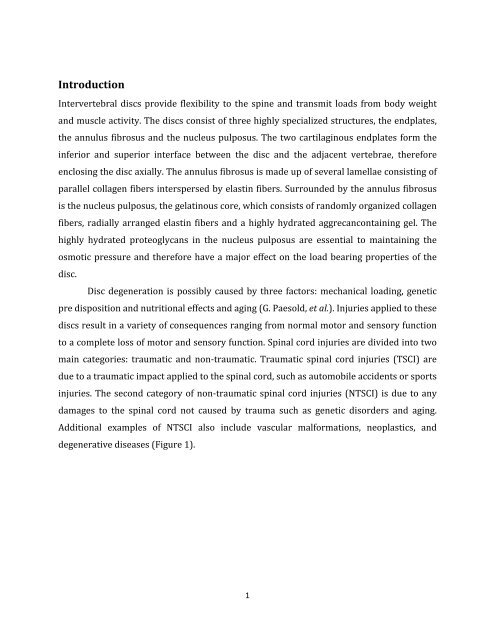Intervertebral Disk Replacement - Keivan Anbarani's Electronic ...
Intervertebral Disk Replacement - Keivan Anbarani's Electronic ...
Intervertebral Disk Replacement - Keivan Anbarani's Electronic ...
You also want an ePaper? Increase the reach of your titles
YUMPU automatically turns print PDFs into web optimized ePapers that Google loves.
Introduction<br />
<strong>Intervertebral</strong> discs provide flexibility to the spine and transmit loads from body weight<br />
and muscle activity. The discs consist of three highly specialized structures, the endplates,<br />
the annulus fibrosus and the nucleus pulposus. The two cartilaginous endplates form the<br />
inferior and superior interface between the disc and the adjacent vertebrae, therefore<br />
enclosing the disc axially. The annulus fibrosus is made up of several lamellae consisting of<br />
parallel collagen fibers interspersed by elastin fibers. Surrounded by the annulus fibrosus<br />
is the nucleus pulposus, the gelatinous core, which consists of randomly organized collagen<br />
fibers, radially arranged elastin fibers and a highly hydrated aggrecancontaining gel. The<br />
highly hydrated proteoglycans in the nucleus pulposus are essential to maintaining the<br />
osmotic pressure and therefore have a major effect on the load bearing properties of the<br />
disc.<br />
Disc degeneration is possibly caused by three factors: mechanical loading, genetic<br />
pre disposition and nutritional effects and aging (G. Paesold, et al.). Injuries applied to these<br />
discs result in a variety of consequences ranging from normal motor and sensory function<br />
to a complete loss of motor and sensory function. Spinal cord injuries are divided into two<br />
main categories: traumatic and non-‐traumatic. Traumatic spinal cord injuries (TSCI) are<br />
due to a traumatic impact applied to the spinal cord, such as automobile accidents or sports<br />
injuries. The second category of non-‐traumatic spinal cord injuries (NTSCI) is due to any<br />
damages to the spinal cord not caused by trauma such as genetic disorders and aging.<br />
Additional examples of NTSCI also include vascular malformations, neoplastics, and<br />
degenerative diseases (Figure 1).<br />
1


